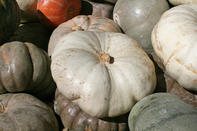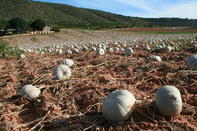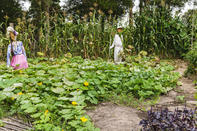Propagation
Pumpkin and Hubbard squash propagation is by seed. The seed is formed in a cavity in the fruit.
Planting Method
Planting is done by direct sowing the squash seeds manually or by mechanical planters. The planting of seedlings prepared in seed trays with peat or plant medium is also popular as this leads to earlier harvesting times.
Seeds can be planted and germinated earlier under cover or in greenhouses in the cold winter weather of July and early August.
Spacing

Creeping vine types should be spaced 75 to 100 cm apart in rows that are 200 cm apart. This is between 5 000 and 8 000 plants per hectare.
The bush types can be spaced 50 to 75 cm apart in rows that are 150 to 200 cm apart. This is between 8 000 and 10 000 plants per hectare.
Sowing Time
Direct sowing of pumpkin or squash seeds is normally done when soil temperatures start increasing in spring. This can be anytime from the middle of September to beginning of October.Planting Time
The planting of seedlings is when temperatures start increasing, the same time as seed planting. This is Mid-September to early October.Growth Period

Fertilization
It is normally enough to fertilize twice, once at planting and again 6 to 8 weeks after planting. At planting, apply a mixture of all three major macronutrients, Nitrogen (N), Phosphate (P) and Potassium (K).
This can be in the form of about 750 kilograms of 2:3:4 (30) per hectare disc ploughed into the top 20 cm of soil just before planting the seedlings. When pumpkin and Hubbard squash seeds are direct sown or planted the same application as above can be applied just after seedlings have germinated and are about five centimetres tall.
Try to concentrate these applications along the plant rows close to the forming root zone and so as not to feed the weeds. Weeds must be kept under control during these first weeks. A second application of about 300 kilograms of LAN per hectare can be applied 6 to 8 weeks after planting.
Irrigation
Soil moisture should be monitored at least twice a week. This is done manually with a spade or an auger or by placing moisture meters throughout the field. Water stress is very damaging and can considerably reduce production. Normally 30 mm to 35 mm of irrigation per week will be enough.
If temperatures increase then irrigation scheduling needs to be adjusted accordingly. As the roots are mostly concentrated near the surface the irrigation can be split into two applications per week. This is especially advisable on sandier soils and when temperatures are high.
By Louise Brodie